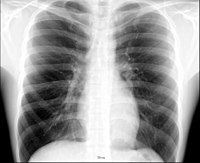
Photo from wikipedia
Background Less invasive procedures have replaced open surgical treatment in many cardiovascular disorders. During these interventions, iatrogenic cardiac perforation may ensue, which is a severe complication and requires immediate diagnostic… Click to show full abstract
Background Less invasive procedures have replaced open surgical treatment in many cardiovascular disorders. During these interventions, iatrogenic cardiac perforation may ensue, which is a severe complication and requires immediate diagnostic assessment and treatment. Methods From March 2011 to April 2016, all patients referred to the Dept. of Cardio-thoracic Surgery with the diagnosis of iatrogenic perforation of myocardial wall or great vessels were included into the retrospective study. Complications during transapical transcutaneous aortic valve replacements (TAVR) procedures and percutaneous coronary intervention (PCI) were excluded from analysis. Symptoms, therapeutic strategy, intraoperative findings, and outcome were evaluated. Results Forty-four patients suffered from myocardial wall or vessel perforation. Most common site of perforation were right (n=26; 59.1%) and left (n=8; 18.2%) ventricle. Other structures were involved in ten cases (22.7%). Open surgical treatment was required in 27 cases (61.4%). Mortality after left and right ventricular laceration was 75.0% and 11.5%, respectively. Most common cause of death was cardiocirculatory failure (n=5). Conclusions Iatrogenic perforation of myocardial wall or central vessels during percutaneous interventional procedures is a rare but life-threatening complication. Despite immediate treatment efforts, mortality is high, particularly after left ventricular laceration.
Journal Title: Journal of thoracic disease
Year Published: 2017
Link to full text (if available)
Share on Social Media: Sign Up to like & get
recommendations!